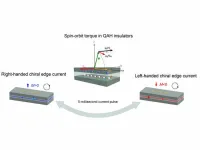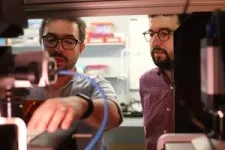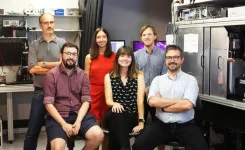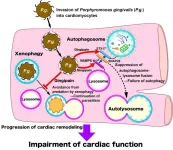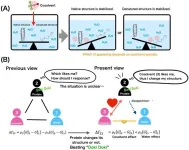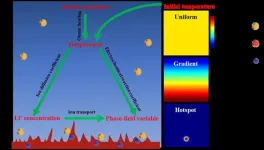(Press-News.org) UNIVERSITY PARK, Pa. — A new electrical method to conveniently change the direction of electron flow in some quantum materials could have implications for the development of next-generation electronic devices and quantum computers. A team of researchers from Penn State developed and demonstrated the method in materials that exhibit the quantum anomalous Hall (QAH) effect — a phenomenon in which the flow of electrons along the edge of a material does not lose energy. The team described the work in a paper appearing today (Oct. 19) in the journal Nature Materials.
“As electronic devices get smaller and computational demands get larger, it is increasingly important to find ways to improve the efficiency of information transfer, which includes the control of electron flow,” said Cui-Zu Chang, Henry W. Knerr Early Career Professor and associate professor of physics at Penn State and co-corresponding author of the paper. “The QAH effect is promising because there is no energy loss as electrons flow along the edges of materials.”
In 2013, Chang was the first to experimentally demonstrate this quantum phenomenon. Materials exhibiting this effect are referred to as QAH insulators, which are a type of topological insulator — a thin layer of film only a couple dozen atoms thick — that have been made magnetic so that they only conduct current on their edges. Because the electrons travel cleanly in one direction, the effect is referred to as dissipationless, meaning no energy is lost in the form of heat.
“In a QAH insulator, electrons on one side of the material travel in one direction, while those on the other side travel in the opposite direction, like a two-lane highway,” Chang said. “Our earlier work demonstrated how to scale up the QAH effect, essentially creating a multilane highway for faster electron transport. In this study, we develop a new electrical method to control the transport direction of the electron highway and provide a way for those electrons to make an immediate U-turn.”
The researchers fabricated a QAH insulator with specific, optimized properties. They found that applying a 5-millisecond current pulse to the QAH insulator impacts the internal magnetism of the material and causes the electrons to change directions. The ability to change direction is critical for optimizing information transfer, storage, and retrieval in quantum technologies. Unlike current electronics, where data is stored in a binary state as on or off — as one or zero — quantum data can be stored simultaneously in a range of possible states. Changing the flow of electrons is an important step in writing and reading these quantum states.
“The previous method to switch the direction of electron flow relied on an external magnet to alter the material’s magnetism, but using magnets in electronic devices is not ideal,” said Chao-Xing Liu, professor of physics at Penn State and co-corresponding author of the paper. “Bulky magnets are not practical for small devices like smartphones, and an electronic switch is typically much faster than a magnetic switch. In this work, we found a convenient electronic method to change the direction of electron flow.”
The researchers previously optimized the QAH insulator so that they could take advantage of a physical mechanism in the system to control its internal magnetism.
“To make this method effective, we needed to increase the density of the applied current,” Liu said. “By narrowing the QAH insulator devices, the current pulse resulted in very high current density that switched the magnetization direction, as well as the direction of the electron transport route.”
This shift from magnetic to electronic control in quantum materials, according to the researchers, is similar to a shift that has occurred in traditional memory storage: While the storage of information on original hard drives and floppy disks involved the use of magnets to create a magnetic field and write data, newer “flash memory” such as that used in USB drives, solid state hard drives, and smartphones is written electronically. Promising new technologies to scale up memory, such as MRAM, similarly rely on physical mechanisms related to internal magnetism.
Beyond the experimental demonstration, the research team also provided a theoretical interpretation of their methodology.
The team is currently exploring how to pause electrons on their route — to essentially turn the system on and off. They are also pursuing how to demonstrate the QAH effect at higher temperatures.
“This effect, as well as current requirements for quantum computers and superconductors, require very low temperatures near absolute zero,” Chang said. “Our long-term goal is to replicate the QAH effect at more technologically relevant temperatures.”
In addition to Chang and Liu, the research team at Penn State at the time of the research includes postdoctoral researchers Wei Yuan, Yang Wang, and Hemian Yi; graduate students Ling-Jie Zhou, Kaijie Yang, Yi-Fan Zhao, Ruoxi Zhang, Zijie Yan, Deyi Zhuo, and Ruobing Mei; Morteza Kayyalha, assistant professor of electrical engineering; and Moses Chan, Evan Pugh University Professor Emeritus of Physics.
The Army Research Office, the Air Force Office of Scientific Research, and the National Science Foundation (NSF) funded this research. The NSF-funded Materials Research Science and Engineering Center for Nanoscale Science at Penn State and the Gordon and Betty Moore Foundation’s EPiQS Initiative provided additional support.
END
Electrical control of quantum phenomenon could improve future electronic devices
For the first time, researchers demonstrate how to electronically alter the direction of electron flow in promising materials for quantum computing
2023-10-19
ELSE PRESS RELEASES FROM THIS DATE:
A change in rigidity switches the function of protein condensates involved in sensing touch
2023-10-19
Touch plays a fundamental role in our physical, emotional, and social well-being. From a primary way of conveying emotions to sensory integration, it is crucial for the complex growth of cognitive, emotional, social, and behavioral abilities especially during the early development of infants and children. Touch allows us to build connections with others, eases pain and stress, and helps us to understand the world around us giving crucial information such as the texture, temperature, and shape of objects.
When sensing any stimuli, such as when the body is being touched, the mechanical signals are transformed into biological responses ...
From square to cube: Hardware processing for AI goes 3D, boosting processing power
2023-10-19
A breakthrough development in photonic-electronic hardware could significantly boost processing power for AI and machine learning applications.
The approach uses multiple radio frequencies to encode data, enabling multiple calculations to be carried out in parallel.
The method shows promise for outperforming state-of-the-art electronic processors, with further enhancements possible.
In a paper published today in Nature Photonics, researchers from the University of Oxford, along with collaborators from the Universities of Muenster, Heidelberg, and Exeter, report on their development ...
Self-powered flexible multicolor electrochromic devices for information displays
2023-10-19
In recent years, self-powered electrochromic (EC) devices have shown significant potential in various fields such as optoelectronics, sensors, and security systems. These self-powered EC systems, capable of reversible color switching without external power sources, have garnered considerable interest for next-generation electronic devices. However, this field is still in its infancy, with several unresolved challenges, including monochromatic displays, limited cycle durability, and the use of aqueous electrolytes. All these limitations have become ...
Urgent action needed to address climate change threats to coastal areas
2023-10-19
Global coastal adaptations are ‘incremental in scale’, short-sighted and inadequate to address the root causes of vulnerability to climate change, according to an international team of researchers.
The 17 experts, including Prof Robert Nicholls, Professor of Climate Adaptation at the University of East Anglia (UEA), have contributed to the paper, ‘Status of global coastal adaptation’, which is published today in Nature Climate Change.
Prof Nicholls said: “Recent analyses conclude that despite adaptation undertaken in all regions and sectors, global action remains incremental in scale: policies and projects ...
Cancer drug that targets two immune-evading tumor tactics performs well in early clinical trial
2023-10-19
A “two-for-one” cancer immunotherapy is potentially more effective and at least as safe as standard immunotherapies, physician-scientists from UPMC Hillman Cancer Center who led an international, early-phase clinical trial report today in the journal Nature Medicine.
The findings, which involved hundreds of patients with different types of advanced solid tumors or blood cancers, point to an enticing new path for bispecific therapies that more efficiently unleash the patient’s own immune system to eliminate the cancer.
“No approved ...
International team develops novel DNA nano engine
2023-10-19
An international team of scientists has recently developed a novel type of nano engine made of DNA. It is driven by a clever mechanism and can perform pulsing movements. The researchers are now planning to fit it with a coupling and install it as a drive in complex nano machines. Their results were just published today in the journal Nature Nanotechnology.
Petr Šulc, an assistant professor at Arizona State University's School of Molecular Sciences and the Biodesign Center for Molecular Design and Biomimetics, has collaborated with professor ...
Killer smile? An oral pathogen increases heart attack damage
2023-10-19
Researchers from Tokyo Medical and Dental University(TMDU) find that a periodontal pathogen, Porphyromonas gingivalis, inhibits autophagosome–lysosome fusion, and can therefore worsen cardiac remodeling and cause cardiac rupture after myocardial infarction
Tokyo, Japan – Brushing and flossing regularly can keep your smile shining as brightly as ever, but did you know that it could also help protect your heart? Now, researchers in Japan report that an infected mouth could lead to a broken ...
Modulation of protein stability: a new approach to studying cosolvent effects
2023-10-19
Controlling the process of destabilization is important when manipulating the unfolding and refolding of proteins in vitro (outside their native environment). To this end, urea and alcohol are used as cosolvents, substances added in small amounts along with water, to destabilize and denature proteins. Urea disturbs a native protein to produce disordered coils, and the interference by alcohol treatment yields helical structures. Research on the mechanism of cosolvents has shown that a protein’s stability between its native and denatured states is tied ...
Hook-ups where one partner is drunker more likely to be seen as assault
2023-10-19
Hook-ups where one partner is drunker than the other are more likely to be seen as assault, researchers at the University of Essex revealed.
A study by Dr Veronica Lamarche, from the Department of Psychology, discovered equal consumption was more important than levels of drunkenness.
This was the case even when couples had drunk to excess and was the same across sexualities and genders.
Dr Lamarche discovered that romantic rendezvous were seen most positively when couples drank the same low level of alcohol.
And encounters where one partner was ...
Unified picture on temperature dependence of lithium dendrite growth via phase-field simulation
2023-10-19
They published their work on Sep. 12 in Energy Material Advances.
"The great electrochemical phase-field simulation efforts devoted to exploring the dendrite growth mechanism under the temperature field recently," said paper author Shi, School of Materials Science and Engineering, Shanghai University. "The uniformity of temperature distribution inside batteries has a substantial impact on the stability of Li electrodeposition and dissolution, and the mechanism underlying the temperature-dependent Li dendrite growth remains controversial."
Shi said ...
LAST 30 PRESS RELEASES:
Post-stroke injection protects the brain in preclinical study
Cardiovascular risk score predicts multiple eye diseases
Health: estimated one in ten British adults used or interested in GLP-1 medications for weight loss
Exercise to treat depression yields similar results to therapy
Whooping cough vaccination for pregnant women strengthens babies’ immune system
Dramatic decline in new cases of orphanhood in Uganda driven by HIV treatment and prevention programs
Stopping weight loss drugs linked to weight regain and reversal of heart health markers
Higher intake of food preservatives linked to increased cancer risk
Mass General Brigham–developed cholera vaccine completes phase 1 trial
First experimental validation of a “150-year-old chemical common sense” direct visualization of the molecular structural changes in the ultrafast anthracene [4+4] photocycloaddition reaction
Lack of support for people on weight loss drugs leaves them vulnerable to nutritional deficiencies, say experts
Dogs’ dinners can have greater climate impact than owners’
Are you ready to swap salmon for sprats and sardines?
1.6 million UK adults used weight loss drugs in past year
American College of Cardiology comments on new dietary guidelines for Americans
American Society of Gene & Cell Therapy and Orphan Therapeutics Accelerator partner to advance and commercialize promising rare disease treatments
One in 14 patients having day case surgery have new or worse chronic pain 3 months after their operation
New study highlights link between eviction rates and gun violence
Heatwaves heat up soil but not toxin levels in rice, study finds
Digital modeling reveals where construction carbon emissions really come from
Turning farm waste into water filters
New study shows how the spleen helps the immune system accept a transplant
New Mayo Clinic study advances personalized prostate cancer education with an EHR-integrated AI agent
Researchers identify novel therapeutic target to improve recovery after nerve injury
Microbes in breast milk help populate infant gut microbiomes
Reprogramming immunity to rewrite the story of Type 1 diabetes
New tool narrows the search for ideal material structures
Artificial saliva containing sugarcane protein helps protect the teeth of patients with head and neck cancer
Understanding the role of linear ubiquitination in T-tubule biogenesis
Researchers identify urban atmosphere as primary reservoir of microplastics
[Press-News.org] Electrical control of quantum phenomenon could improve future electronic devicesFor the first time, researchers demonstrate how to electronically alter the direction of electron flow in promising materials for quantum computing
